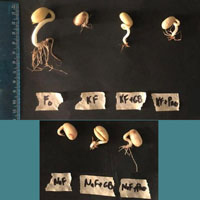First insight of exogenous addition of proline and glycinebetaine to mitigate fluorine toxicity effects on common bean seedlings
DOI:
https://doi.org/10.4081/ija.2020.1754Keywords:
Fluoride, salt stress, salt tolerance, osmoprotection, osmolytes.Abstract
To counteract fluoride (F) stress-induced adverse effects on plants, one approach is the application of exogenous potential osmoprotectants such as proline (Pro) and glycinebetaine (GB). This experiment was carried out to evaluate the effects of exogenous application of Pro and GB on germination and growth of common bean seeds after potassium fluoride (KF) and sodium fluoride (NaF) exposure. The study was replicated under two different temperatures: the normal temperature required for seeds growth (20°C) and a higher (25°C) favourable for bean cultivation in Africa, the region most polluted with F. The results indicated that the beneficial effects of external supply of Pro and GB varied depending on temperature and the source of salt stress. NaF showed a more toxic effect than KF on growth of Phaseolus vulgaris seeds. Overall, Pro was more effective than GB to alleviate the undesirable effect of salt stress on morphological attributes under NaF stress (improving by 50% and 39% the length and the number of lateral roots), and especially at higher temperature the recovery role of Pro and GB was more relevant reaching the same value found under control conditions for the length of hypocotyl (3.28 cm).
Highlights
- Exogenous glycinebetaine and proline were able to counteract F inhibitory effects on Phaseolus vulgaris seedlings growth.
- Sodium fluoride (NaF) showed more toxic effect than potassium fluoride (KF) on Phaseolus vulgaris seedlings growth.
- Proline was more effective than glycinebetaine in alleviating F toxicity effects on seedlings growth.
Downloads
References
Annunziata MG, Ciarmiello L F, Woodrow P, Dell’Aversana E, Carillo P, 2019. Spatial and temporal profile of glycine betaine accumulation in plants under abiotic stresses. Front. Plant Sci. 10:230, 1-13.
Ashraf M, Foolad MR, 2007. Roles of glycine betaine and proline in improving plant abiotic stress resistance. Environ. Exp. Bot. 59:206-16.
Banerjee A, Roychoudhury A, 2019a. Fluorine: a biohazardous agent for plants and phytoremediation strategies for its removal from the environment. Biol. Plant. 63:104-12.
Banerjee A, Roychoudhury A, 2019b. Structural introspection of a putative fluoride transporter in plants. 3. Biotech. 9:103.
Beebe SE, Rao IM, Mukankusi C, Buruchara RA, 2012. Improving resource use efficiency and reducing risk of common bean production in Africa, Latin America, and the Caribbean. In: Hershey, Clair H. (ed.). Eco-Efficiency: From vision to reality. Centro Internacional de Agricultura Tropical (CIAT), Cali, CO. 18 p.
Bharti VK, Giri A, Kumar K, 2017. Fluoride sources, toxicity and its amelioration: a review. Ann. Environ. Sci. Toxicol. 2:21-32.
Binagwa PH, Magdalena W, Michael K, Zakayo E, Mbiu J, Msaky J, Mdachi, M, Kasubiri F, Kisamo A, Nestory SM, Rubyogo JC, 2018. Selian Agricultural Research Institute (SARI) Released Seven (7) Improved Common Bean (Phaseolus vulgaris) Varieties; January 2018. Fact Sheet 1.
Chandrakar V, Dubey A, Keshavkant S, 2016. Modulation of antioxidant enzymes by salicylic acid in arsenic exposed Glycine max L. J. Soil Sci. Plant Nutr. 16:662-76.
Dar MI, Naikoo MI, Rehman F, Naushin F, Khan FA, 2016. Proline accumulation in plants: roles in stress tolerance and plant development. In: N. Iqbal, R. Nazar, A.N. Khan (Eds.), Osmolytes and plants acclimation to changing environment: emerging omics technologies. Springer, New Delhi, India. Available from: https://doi.org/10.1007/978-81-322-2616-1_9
Debska K, Bogatek R, Gniazdowska A, 2012. Protein carbonylation and its role in physiological processes in plants. Postepy Biochem. 58:34-43.
Demiİr Y, Kocaçalişkan İ, 2001.Effects of NaCl and proline on polyphenol oxidase activity in bean seedlings. Biol. Plant. 44:607-9.
Lutts S, 2000. Exogenous glycinebetaine reduces sodium accumulation in salt-stressed rice plants. IRRN 25:9-40.
Mondal D, Gupta S, 2015. Influence of fluoride contaminated irrigation water on biochemical constituents of different crops and vegetables with an implication to human risk through diet. J. Mater. Environ. Sci. 6:3134-2.
Nounjan N, Nghia PT, Theerakulpisut P, 2012. Exogenous proline and trehalose promote recovery of rice seedlings from salt-stress and differentially modulate antioxidant enzymes and expression of related genes. J. Plant Physiol. 169:596-604.
Panda D, 2015. Fluoride toxicity stress: physiological and biochemical consequences on plants. Int. J. Bio-res. Env. Agril. Sci.1:70-84.
Rady MM, Taha RS, Mahdi AHA, 2015. Proline enhances growth, productivity and anatomy of two varieties of Lupinus termis L. Grown under salt stress. S. Afr. J. Bot. 102:221-7.
Sofy MR, Elhawat N, Alshaal T, 2020. Glycine betaine counters salinity stress by maintaining high K+/Na+ ratio and antioxidant defense via limiting Na+ uptake in common bean (Phaseolus vulgaris L.). Ecotoxicol. Environ. Safety 200:1-12.
Wortmann CS, Kirkby R, Eledu C, Allen DJ, 1998. Atlas of common bean production in Africa. Centro Internacional de Agricultura Tropical, Cali, Colombia. 133 p. Illus. -- (CIAT publication; no. 297).
Yadu B, Chandrakar V, Keshavkant S, 2016. Responses of plants to fluoride: An overview of oxidative stress and defense mechanisms. Fluoride 49:293-302.
Yadu B, Chandrakar V, Meena RK, Keshavkant S, 2017. Glycinebetaine reduces oxidative injury and enhances fluoride stress tolerance via improving antioxidant enzymes, proline and genomic template stability in Cajanus cajan L. S. Afr. J. Bot. 111:68-75.

Published
How to Cite
Issue
Section
License
Copyright (c) 2021 The Author(s)

This work is licensed under a Creative Commons Attribution-NonCommercial 4.0 International License.
PAGEPress has chosen to apply the Creative Commons Attribution NonCommercial 4.0 International License (CC BY-NC 4.0) to all manuscripts to be published.
